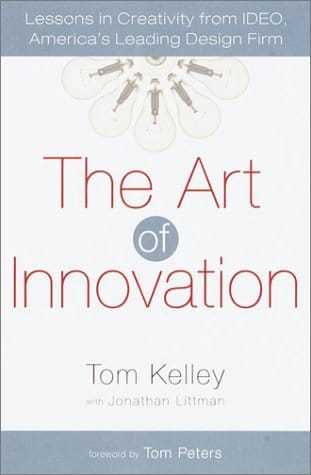As creative entrepreneurs, we’re often encouraged to think outside the box.
But what if I told you that putting a box around your ideas could actually lead to more innovation?
In this newsletter, after sharing the latest podcast episode, we’ll dive into practical methods like the SCAMPER technique, explore different types of constraints, and provide resources to help you apply these concepts to your creative process today.
Whether you’re working on a new project or refining your business strategy, these practices will help you focus your efforts and generate more impactful ideas.
Links to Podcast Content
To get the full context into the topic, listen to the latest episode of the Everyday Innovation podcast.
As you listen, feel free to follow along and add to the experience with additional resources below.
Spotify
Don't see a Spotify embed above? Click here to watch/listen!
YouTube
Apple
Don't see an Apple embed above? Click here to listen!
SCAMPER: A Tool for Creative Problem-Solving

One of the most effective ways to implement creative constraints is by using the SCAMPER method. This technique helps you innovate by focusing on specific actions that modify or improve existing ideas.
Substitute: Try a New Approach
- Creative Example: Replace traditional paint with digital painting tools to create a unique art piece.
- Entrepreneurial Example: Use a subscription-based model instead of a one-time purchase model to create recurring revenue.
Combine: Merge Different Elements
- Creative Example: Combine photography with digital illustration to produce mixed-media art.
- Entrepreneurial Example: Offer a physical product with a digital service—like an online course alongside a book—to enhance customer value.
Adapt: Apply Techniques in New Ways
- Creative Example: Adapt portrait photography techniques to create a new style of product photography.
- Entrepreneurial Example: Host temporary online stores featuring exclusive products, adapting the pop-up shop concept to an online environment.
Modify: Make Strategic Changes
- Creative Example: Modify a classic narrative structure by starting in the middle of the story to create a more engaging plot.
- Entrepreneurial Example: Modify an app interface based on user feedback to make it more intuitive and user-friendly.
Put to Another Use: Repurpose Existing Ideas
- Creative Example: Use old canvases as the base for new, layered artwork, giving materials a new life.
- Entrepreneurial Example: Repurpose a failed product’s technology for a new market, turning a previous loss into a potential success.
Eliminate: Simplify for Impact
- Creative Example: Eliminate unnecessary elements in a design project for a minimalist and powerful final piece.
- Entrepreneurial Example: Eliminate intermediaries in a supply chain to reduce costs and increase profit margins by selling directly to consumers.
Reverse: Flip the Process
- Creative Example: Reverse the typical songwriting process by starting with the melody instead of the lyrics, leading to innovative results.
- Entrepreneurial Example: Provide proactive customer support with AI-driven notifications, addressing issues before customers realize they have them.
Actionable Practice: Take a current project or problem you're facing and run it through the SCAMPER method. See how many new ideas you can generate by applying each of these steps.
Types of Creative Constraints
Time Constraints: Deadlines as Creative Catalysts
Deadlines are classic constraints that can spur action and prioritize focus.
• Creative Example: Set a deadline for completing a piece of artwork, forcing you to make quick, decisive choices in your creative process.
• Entrepreneurial Example: Implement a 24-hour hackathon to push your team to rapidly prototype a new product idea.
Actionable Practice: Set a strict time limit for your next creative task. Whether it’s a five-minute video script or a one-week MVP challenge, use this constraint to refine your ideas and push through to completion.
Resource Constraints: Maximizing Efficiency and Creativity
Working with limited resources can lead to more innovative solutions.
• Creative Example: Create a sculpture using only recycled materials, challenging you to find beauty and function in what others might discard.
• Entrepreneurial Example: Develop a Minimum Viable Product (MVP) using only existing tools and technology to test your concept quickly and cost-effectively.
Actionable Practice: Challenge yourself to complete a project using only the resources you currently have at hand. This could mean designing a new product with existing tools or creating content using repurposed materials.
Scope Constraints: Focusing Your Efforts
Narrowing the scope of a project can help you focus and produce more targeted results.
• Creative Example: Limit your photography project to a single color theme, forcing you to explore creative compositions and perspectives within that constraint.
• Entrepreneurial Example: Focus on solving a specific pain point for a niche market rather than trying to appeal to everyone, leading to a more innovative and effective product.
Actionable Practice: Define the specific scope of your next project, whether it’s by theme, target audience, or the type of content you’re creating. This focus can help you generate more impactful and coherent results.
Collaboration Constraints: Small Teams, Big Ideas
Working with a small team or a specific set of collaborators can lead to more streamlined and innovative outcomes.
• Creative Example: Collaborate with only one other artist on a project, forcing both of you to integrate your styles and ideas in new ways.
• Entrepreneurial Example: Start with a small, agile team that can move quickly and iterate on ideas without getting bogged down in bureaucracy.
Actionable Practice: Consider the size and composition of your team for your next project. Smaller teams can often move faster and innovate more freely, so try starting with a core group before expanding.
Recommended Resources

Books on Creative Constraints
These books provide deeper content into how constraints can fuel creativity and innovation, offering practical advice and real-world examples.
Podcast Episodes on Creative Constraints
Listen to these episodes for more insights into how constraints can lead to greater creativity in various contexts (these are Spotify embeds, but you can search elsewhere under these titles).




Other Resources









Join the conversation